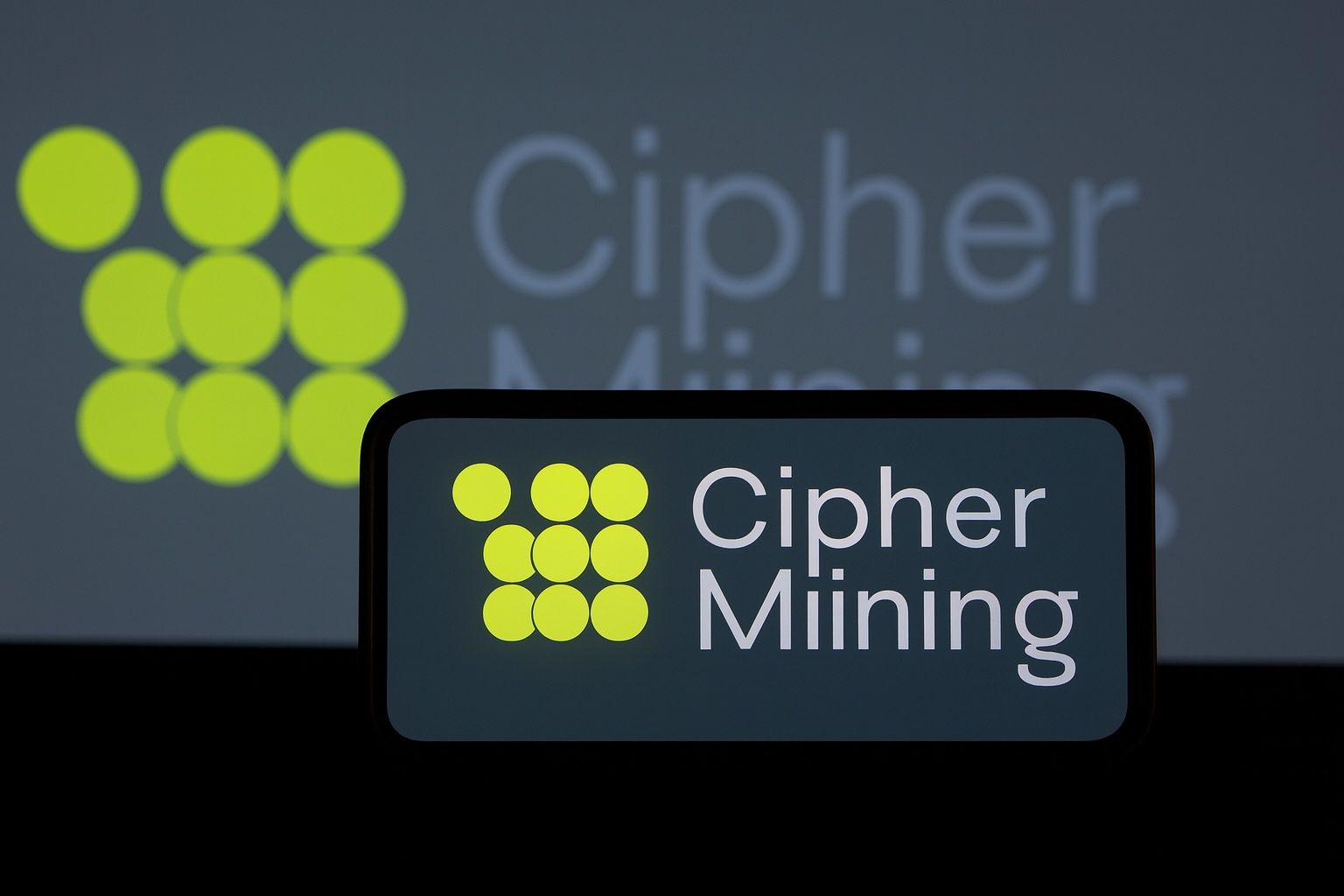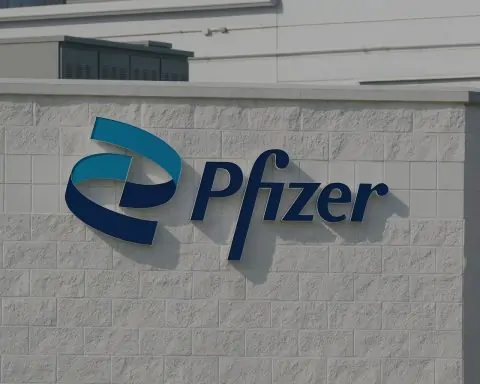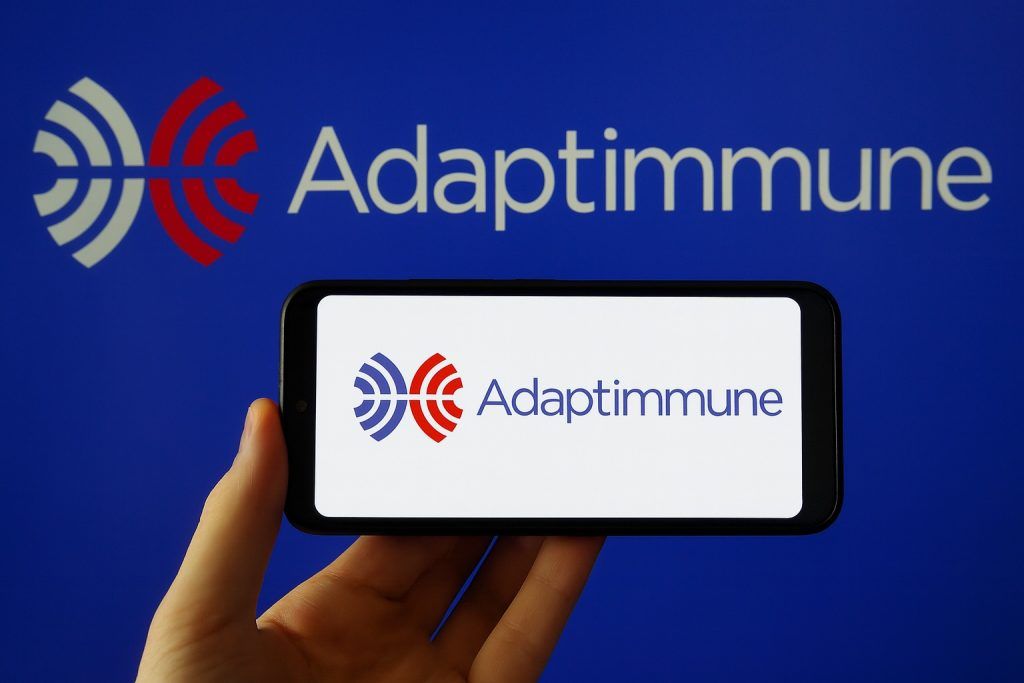- Stock Ticker: CIFR (Cipher Mining Inc.) – NASDAQ
- Market Cap: ~$5.4–6.0 billion (early Oct 2025) [1]
- Sector/Industry: Cryptocurrency mining & data-center infrastructure (Bitcoin mining and HPC hosting) [2]
- CEO: Tyler Page [3]
- Latest Price: ≈$15–$16 per share (Oct 8, 2025), near all-time highs (~$15.54 52-week high) [4]
- Recent Performance: ▲ +320% year-to-date and ▲ ~480% over the last 6 months [5] [6], vastly outperforming crypto-mining peers.
Company Overview: Operations & Business Model
Cipher Mining Inc. is a pure-play Bitcoin miner operating industrial-scale data centers with a focus on ultra-low-cost power [7]. The company strategically locates its facilities in regions with cheap, renewable-rich electricity (e.g. West Texas), often building behind-the-meter or adjacent to wind and solar farms [8] [9]. Its flagship “Black Pearl” site near Odessa, TX is a 150 MW facility designed for both Bitcoin mining and high-performance computing (HPC) workloads [10].
As of mid-2025, Cipher’s deployed hashrate reached about 16.8 EH/s (exahashes per second), using next-gen ASIC machines for high energy efficiency [11]. The company had aggressively expanded capacity – a 2.6 GW development pipeline of power projects positions Cipher for further growth [12]. Management guided toward ~23.5 EH/s of self-mining capacity by Q3 2025 [13], indicating continued installation of miners and facility build-outs. This would place Cipher among the largest global Bitcoin miners by hashrate. Notably, its operations produced ~150 BTC in Q2 2025 and the firm plans further upgrades beyond 2025 to stay at the cutting edge [14] [15].
Cipher’s business model emphasizes operational efficiency and scale: it reinvests cash flows into capacity growth and has utilized strategic financing (like convertible debt) to fund expansions without sacrificing ownership of assets [16] [17]. The company’s pivot into HPC hosting (AI cloud infrastructure) in 2025 further diversifies its revenue streams beyond just earning Bitcoin. By leveraging its large data-center footprint and abundant power access, Cipher aims to host third-party AI and cloud computing hardware, generating stable, contracted income alongside its core Bitcoin mining revenues [18]. This “Bitcoin + AI” dual strategy is relatively unique in the sector and is intended to capitalize on surging demand for AI compute power while buffering against crypto volatility.
Latest News (Sept–Oct 2025)
Google-Backed AI Hosting Deal: The biggest recent development for Cipher was a landmark 10-year agreementannounced in late September 2025 with Fluidstack, an HPC infrastructure firm, to host 168 MW of high-performance computing at Cipher’s new Barber Lake data center [19]. Critically, the deal is backed by Google as a strategic partner – Google will underwrite $1.4 billion of the contract (and reportedly took a ~5.4% equity stake in Cipher) [20]. The contract is expected to generate roughly $3 billion in revenue over the decade, with potential extensions that could boost the total value up to $7 billion [21]. This AI-colocation venture essentially repurposes part of Cipher’s capacity for cloud computing tasks, marking a bold pivot from pure crypto mining. Investors greeted the news enthusiastically, as it provides a long-term, stable cash flow source and validates Cipher’s strategy via endorsement from a tech giant. “The mix of business expansion and the Google deal has propelled the company’s stock amid a broader Bitcoin bull market, pushing its market capitalization to approximately $5 billion,” noted Yahoo Finance [22]. Following announcement of the Google/Fluidstack partnership, multiple analysts upgraded the stock (details below), and shares soared over 10% in a day to new highs [23].
Zero-Coupon Financing: Alongside the HPC deal, Cipher raised $1.1 billion via a convertible note offering to finance the build-out of the Barber Lake facility [24]. This zero-coupon convertible note structure provides needed capital without immediate dilution to shareholders, while allowing Cipher to maintain 100% ownership of the new data center [25]. The hefty investment underscores management’s confidence in high-margin AI hosting demand and effectively leverages Google’s backing to fund growth. Analysts viewed this financing positively, as it secures funding for expansion into AI infrastructure with manageable long-term cost [26] [27].
Rally on Bitcoin’s Surge: These corporate moves coincided with a powerful upswing in Bitcoin’s price through late September and early October. Bitcoin reached ~$116,000 around Oct 1, 2025 – its highest level in years [28] – amid a broad crypto bull market (fueled by U.S. ETF approval and macro trends). The Bitcoin rally amplified optimism for all mining stocks. Cipher, being highly leveraged to BTC’s price, saw its stock skyrocket (more on performance below). As one example of the excitement, on October 8 the stock jumped another ~13% intraday after fresh analyst commentary, briefly trading above $18 [29] [30].
Other Developments: In early October, Cipher announced a leadership change in its finance team. Longtime CFO Ed Farrell will retire (effective Oct 14, 2025) and will be succeeded by Greg Mumford as the new CFO [31] [32]. Mr. Mumford joins from an investment banking background in digital assets and is expected to help guide Cipher’s capital markets strategy as it scales. Additionally, Cipher’s Q2 2025 operational update (released in late August) highlighted that its “Black Pearl” facility Phase I came online successfully and that the company’s project pipeline totals ~2.6 GW for future expansions [33]. This positions Cipher to continue growing both its Bitcoin hashing capacity and new HPC hosting ventures in the coming years.
Recent Stock Performance & Price Trends
CIFR’s stock has been on a tear in 2025, dramatically outperforming both the broader market and other crypto mining equities. Year-to-date the stock is up over 320% (as of early Oct 2025) [34], and in just the past six months it has surged roughly 480% [35]. This explosive rise took shares from penny-stock levels under $2 at the start of the year to new all-time highs in the mid-$15s by late September [36]. In fact, CIFR hit a 52-week (and record) high of ~$15.54 in late September amid the wave of bullish news [37]. On October 2 alone, the stock jumped +9.6% to $13.81 on record trading volume (~56 million shares, more than double normal) [38] after the Google-backed deal was publicized. By October 3, it was trading in the $14–$15 range [39], and continued to climb into the following week.
Momentum came to a head on October 8, 2025, when Cipher’s stock spiked above $18 during intraday trading (a ~13% single-day jump) on the back of enthusiastic analyst reports [40] [41]. This rally boosted Cipher’s market capitalization to roughly $5.5–6 billion, up from only ~$600 million one year prior [42]. Such rapid appreciation reflects both the rise in Bitcoin’s price (which directly increases miners’ revenues) and investor excitement over Cipher’s AI pivot and growth trajectory. Notably, volatility is extremely high – the stock’s beta is about 3.1 [43], indicating it moves with triple the volatility of the market. Swings of 10%+ in a day have not been uncommon.
This massive run-up has also stretched valuation metrics. Cipher remains unprofitable on a net income basis, so its trailing P/E is negative (around –31× as of Oct 2025) [44]. On a price-to-sales basis, CIFR trades at a rich multiple (~28× revenue in late September) relative to peers [45], suggesting a lot of growth is already priced in. However, some valuation models still see upside; for instance, a DCF (discounted cash flow) analysis by one research firm estimated an intrinsic value near $31 per share – implying the market may be undervaluing Cipher’s long-term cash generation potential [46]. In any case, the stock’s rapid ascent and high trading volumes point to a speculative fervor. The consensus among Wall Street analysts is bullish but cautious – most rate CIFR a “Buy,” yet the average 12-month price target (around $15 as of early Oct) is roughly where the stock already trades [47] [48]. This could mean the easy gains have been realized unless Cipher continues to exceed growth expectations.
It’s also worth noting that Cipher’s rally, while extreme, is part of a broader sector comeback in 2025. Competing crypto miners like Marathon Digital and Riot Platforms also saw strong stock gains this year (though not to the same extent). By late September, Cipher’s +321% YTD return handily beat Riot’s +147% and Marathon’s +120% gains [49]. Still, Marathon (MARA) and Riot (RIOT) shares were trading around $19–$20 (market caps ~$7 billion each) at quarter-end, slightly above Cipher’s valuation [50]. This suggests investors have now placed Cipher in the same league as these industry leaders in terms of market expectation. Going forward, whether CIFR stock continues to climb will likely depend on sustaining its growth story (both in Bitcoin mining and new AI hosting revenue) and of course on Bitcoin’s own price trajectory.
Financial Results & Key Metrics
Cipher Mining’s financial results reflect a high-growth miner scaling up operations, with improving cash flow metrics but accounting net losses due to heavy depreciation and one-time items. In the latest reported quarter (Q2 2025), Cipher generated $44 million in revenue, a substantial increase year-on-year. This was driven by higher Bitcoin production and the ramp-up of new mining capacity (the Black Pearl site coming online). Importantly, the company achieved positive adjusted earnings: Non-GAAP EBITDA was about $30 million in Q2 [51], indicating solid operational profitability when excluding non-cash charges. However, on a GAAP basis Cipher posted a net loss of ~$46 million for Q2 [52], equivalent to –$0.12 per share. The net loss was largely attributable to non-cash fair value adjustments and depreciation of mining equipment (common in the mining industry, where fluctuating BTC prices and derivative warrants can swing GAAP profits) [53].
This Q2 performance actually marked a significant improvement from Q1 2025, where Cipher had slightly higher revenue (~$49 million) but only $6 million in adjusted EBITDA and a net loss of $39 million [54]. The jump in profitability in Q2 shows the benefit of scale and higher Bitcoin prices – once fixed costs are covered, additional hashrate can greatly boost margins. In fact, Cipher’s Q2 adjusted EBITDA margin was roughly 68% of revenue, a healthy figure indicating efficient operations. It mined approximately 150 BTC during Q2 [55], and by quarter-end the company’s self-mining capacity was 16.8 EH/s (as noted earlier). For the first half of 2025, Cipher’s total revenue was ~$93 million and it has been investing aggressively in growth (as evidenced by capital expenditures and the new note issuance).
Looking back, Cipher only began trading publicly in 2021 and was scaling through 2022–2023, with 2024 being its first full year of meaningful operations. In FY 2024, the company achieved net income of $18 million on revenue of $85 million (with $51 million in adjusted earnings) [56] – one of the few pure-play miners to post a full-year profit in that period, thanks to the late-2024 crypto price rebound. By the end of 2024, Cipher’s fleet reached ~13.5 EH/s capacity [57]. That base set the stage for 2025’s expansion.
Key operational metrics for Cipher are trending positively: the company reports a current mining power cost well below industry average by siting in low-cost regions (though exact cost per BTC is not publicly broken out). Its “Black Pearl” mine is described as one of the more energy-efficient installations, aided by on-site renewable power and advanced cooling technology [58]. Cipher’s balance sheet, pro forma the recent $1.1B convertible note, is highly leveraged (debt/equity jumped with the new financing) [59], but the zero-coupon structure means no cash interest burden in the near term. The company had a sizeable cash and Bitcoin treasury as well, giving it liquidity – though not on the scale of some peers that hold thousands of BTC. As of mid-2025, Cipher’s total assets are largely comprised of mining rigs and infrastructure investments, with the Barber Lake project spend set to substantially increase assets (and debt) going forward.
In summary, Cipher is walking the fine line of rapid growth vs. current profitability that is common in the crypto mining sector. The underlying business is cash-generative (at least when Bitcoin prices cooperate), but accounting profits may lag due to depreciation and financing costs. Investors appear to be valuing CIFR primarily on future earnings potential – betting that the expansions in hashrate and the new HPC hosting revenues will dramatically boost revenues over the next 1–2 years. For instance, analysts at Macquarie project Cipher’s FY2026 revenue to reach about $121 million, with a modest positive EPS of $0.12 [60]. If Bitcoin’s bull cycle continues, those figures could prove conservative; if crypto winter returns, Cipher’s top line would likely undershoot expectations.
Expert Commentary & Analyst Opinions
Wall Street and industry analysts have taken notice of Cipher’s bold moves, and most have turned bullish on the stock in recent months. A flurry of price target upgrades followed the Google/Fluidstack AI deal in late September. For example, Northland Securities raised its target to $14.50, calling the partnership a “crucial growth milestone” with Google’s backing [61]. Canaccord Genuity analyst Joseph Vafi likewise upped his target from $12 to $16, writing that the Fluidstack/Google contract “demonstrates strong demand for AI compute” and creates major value for Cipher by allowing it to retain full ownership of the Barber Lake facility [62]. Needham & Co. applauded the hosting deal as even better than expected, hiking its target to $15 while noting Cipher maintains the full economic benefit of the 168MW deployment [63]. H.C. Wainwright went further, raising its target to $17 per share, and Rosenblatt Securities set a new target of $14, each citing the transformative nature of Cipher’s pivot into AI infrastructure and the positive spillover from Bitcoin’s price rise [64].
Even independent investment outlets have highlighted the surge in optimism. The Motley Fool observed that at least three analysts (including Needham’s Bill Papanastasiou and Rosenblatt’s Chris Brendler) “doubled or sharply increased their price targets,” pointing to the Google-backed HPC agreement plus a ~3% uptick in Bitcoin as dual catalysts for Cipher’s run-up [65] [66]. Overall, by early October there were over a dozen analysts covering CIFR, with the majority assigning “Buy/Outperform” ratings. According to MarketBeat data, 12 out of 14 analysts rated it a buy, and the average target was around $15–$16 (roughly the stock’s trading level) [67] [68]. This consensus reflects confidence in Cipher’s growth but also implies that, after the stock’s huge rally, Wall Street sees a more balanced risk/reward at the current price.
There are some voices of caution as well. Notably, Macquarie Research maintained an Outperform rating on CIFR in late September but issued a caveat: they pointed out that the average one-year price target across all analysts was only about $7.97, which would be ~37% below the prevailing share price [69]. This divergence suggests that while many boutique firms are extremely bullish (hence targets in the mid-teens or higher), a few analysts or models foresee downside if Bitcoin falters or if Cipher’s execution doesn’t live up to the hype. Macquarie essentially warned that expectations are high, and any stumble could lead to a sharp pullback [70].
Another concern some analysts note is Cipher’s aggressive use of debt. While the zero-coupon convertible note is clever financing, it means the company has a large liability due down the road. If the AI hosting revenues ramp up as planned (starting in 2026) and Bitcoin stays strong, Cipher should manage it comfortably. But if not, that debt could become a burden. Still, for now the market sentiment is clearly positive. The phrase “next Bitcoin powerhouse” has been floated in media [71], and Cipher is frequently compared to the likes of Marathon and Riot – a testament to how quickly it has risen from relative obscurity.
Comparison with Peers in Crypto Mining
Cipher Mining is part of a highly competitive crypto-mining sector, which includes several other publicly traded companies. Below is a comparison of CIFR with a few major peers, highlighting recent financials, scale, and strategy:
| Company | Q2 2025 Revenue | Net Income / Adj. EBITDA | Hashrate (EH/s) | Strategy & Notes |
|---|---|---|---|---|
| Cipher Mining (CIFR) | $44 M [72] | –$46 M net, $30 M adj. [73] | 16.8 EH/s (target 23.5) [74] | Low-cost renewable power focus (Texas); expanding into AI/HPC hosting via Google-backed deal. |
| Marathon Digital (MARA) | $238 M (▲64% YoY) [75] | $808 M net (▲505% YoY) [76] | >30 EH/s [77] | One of the largest miners; vertically integrated in U.S. (sites in TX, ND). Exploring high-value compute hosting. |
| Riot Platforms (RIOT) | $153 M [78] | $219.5 M net, $495 M EBITDA [79] | ~12–16 EH/s [80] | Major Texas/Kentucky operations; also building HPC data centers. Receives power credits; average ~$49k cost to mine 1 BTC post-halving [81]. |
| Hut 8 Corp (HUT) | $41.3 M [82] | $137.5 M net, $221 M EBITDA [83] | ~9.3 EH/s (Mar 2025) [84] (→ targeting ~15 EH/s by late 2025) | Canadian-based miner merging with US Bitcoin Corp; diversified into energy (1.0 GW under management) and HPC. Holds ~10.7K BTC in reserve [85]. |
Notes: Cipher’s revenue is smaller than Marathon’s or Riot’s, but it’s growing fast and the pivot to HPC hosting is a differentiator. Marathon and Riot, the two U.S. leaders, benefited from one-time gains in 2025 (e.g. Riot’s power credits, Marathon’s asset revaluations) which boosted their net incomes unusually high [86]. Hut 8 (a prominent Canadian miner) is in the process of a merger and massive expansion – its Q2 net income was positive largely due to that restructuring and possibly fair-value accounting gains. All players have been expanding hashrate aggressively in anticipation of Bitcoin’s 2024–2025 bull cycle and the upcoming halving. Notably, CleanSpark (CLSK), another U.S. miner, recently became the first to reach 50 EH/s of hashrate capacity, with $198.6 M revenue in the June quarter [87]– underscoring how scale is critical in this industry. Cipher at ~23 EH/s (planned) will still be smaller than some peers in raw hashpower, but its emphasis on efficient power and now AI hosting could yield higher margins per PH (petahash) than a brute-force miner.
Overall, Cipher’s valuation (~$5–6 B) now places it in league with Marathon and Riot (each $7–8 B). By comparison, Hut 8 and CleanSpark are a bit smaller ($4–5 B range), and numerous other miners (Bitfarms, Hive Digital, Core Scientific emerging from bankruptcy, etc.) fill out the landscape at lower capitalizations. Investors evaluating CIFR may consider how it stacks up on metrics like cost of production, growth outlook, balance sheet health, and diversificationinto areas like HPC or hosting services. Cipher’s recent strategic moves aim to position it not just as a Bitcoin mining pure-play, but as a broader “digital infrastructure” platform (similar in spirit to what Hive, Hut 8, and others have also signaled).
Outlook and Forecasts
Near-Term (2025–2026): The outlook for Cipher Mining is closely tied to the trajectory of Bitcoin and the execution of its AI hosting venture. In the next year, Cipher plans to fully deploy its remaining mining capacity to reach ~23.5 EH/s, which should materially increase its Bitcoin production assuming network conditions remain favorable [88]. This expansion comes just as the Bitcoin network’s April 2024 halving has reduced block rewards (from 6.25 BTC to 3.125 BTC per block), meaning miners must rely on higher BTC prices or greater hashrate to maintain revenues. Fortunately for Cipher, the post-halving environment has so far seen Bitcoin’s price surging – many analysts predict BTC could hit $130K–$160K by late 2025 or early 2026 if historical cycles repeat [89]. (For context, a panel of 16 crypto analysts compiled by BraveNewCoin even yielded a median price forecast of ~$201K for 2026 [90], though such bullish estimates should be taken with caution.) If Bitcoin approaches those levels, miners like Cipher stand to reap windfall profits, which would likely make current revenue projections too conservative.
On the other hand, Bitcoin’s volatility is a double-edged sword. The halving can also squeeze less efficient miners if price doesn’t rise enough to offset the reward cut – already, industry-wide “hashprice” (revenue per hash) dropped significantly in the year after the 2024 halving [91]. Cipher’s low-cost power strategy gives it some insulation, but a sharp decline in BTC (due to regulatory crackdowns or macroeconomic events) remains the biggest risk to its earnings in the short term.
Meanwhile, late 2025 through 2026 will be pivotal for Cipher’s AI hosting initiative. The Fluidstack/Google contract is set to officially commence by October 2026, at which point Cipher should begin receiving stable, recurring revenues from hosting AI workloads [92]. Canaccord’s analysts noted this materially reduces Cipher’s financing risk going forward, since the HPC deal revenue is more predictable than Bitcoin mining and could justify a stock valuation in the mid-teens (Canaccord pegged ~$16 as fair value) assuming successful execution [93]. In practical terms, the HPC deal essentially pre-fills a large portion of Cipher’s Barber Lake data center capacity with a blue-chip customer (Google via Fluidstack) for 10 years. This means that by 2026, Cipher will effectively have two engines of growth: one tied to crypto markets (mining) and one tied to the secular boom in AI computing demand.
Wall Street forecasts for 2025–26 reflect this optimism tempered by realism. The average analyst estimate for 2025 EPSis around breakeven, improving to a modest profit in 2026 as hosting revenue kicks in [94]. Revenue in 2025 will depend on Bitcoin’s price; at $100K+ BTC, Cipher could easily double its 2024 revenue. By 2026, if both mining and hosting are firing, total revenues could reach the low nine figures ($100M+ annually) [95]. Profit margins should also improve with scale and as the high depreciation from initial build-outs is spread over more revenue streams. That said, some analysts warn that cost inflation (energy prices, mining difficulty increases, interest costs on debt) could eat into margins if not carefully managed [96].
Long-Term (2027 and beyond): Looking further out, Cipher’s ambitions are to become a leader in the next generation of digital infrastructure. The company has indicated plans to leverage a huge 2.6 GW project pipeline by 2028 across sites like Black Pearl (additional phases), Barber Lake, and future locations [97]. If fully realized, that scale of power could support an order-of-magnitude increase in hashrate (potentially >100 EH/s network-wide, through a mix of self-mining and hosting). By 2027–2028, management envisions a portfolio balanced between Bitcoin mining and HPC/co-location hosting, which could make Cipher more resilient to crypto cycles [98]. The $1.1B convertible note financing, which comes due in 2030, was structured to ensure Cipher retains ownership of its key facilities [99] – meaning the company could reap the full benefits of these assets if they appreciate in value (as opposed to joint-venturing or selling stakes to fund them). This could prove very advantageous in the long run if, for example, data center valuations remain high due to AI demand.
However, the landscape in 2028 will bring new challenges as well. The next Bitcoin halving in 2028 will cut block rewards to just 1.5625 BTC [100], which could drastically alter mining economics. Historically, each halving has eventually led to a major BTC bull run (e.g. 2016’s halving preceded a ~30× price explosion by late 2017; the 2020 halving was followed by a 567% BTC gain into 2021) [101]. It’s plausible that by 2028 Bitcoin could be far more valuable – some optimists talk of six-figure or even million-dollar BTC in a decade – but the law of diminishing returnssuggests percentage gains may moderate with each cycle [102] [103]. Cipher’s long-term success will thus depend on staying efficient and diversified. The HPC market itself is growing rapidly (AI, cloud computing, etc.), but it too will be competitive. Cipher may find itself up against dedicated data center players, not just crypto miners, in chasing big hosting contracts by 2030. The good news is that energy is a common denominator, and Cipher’s expertise in sourcing and managing cheap power should translate well into any compute-intensive business.
Analysts generally view Cipher’s long-term forecast as promising but not without risk. On the promising side, the company could, by 2028, be a multi-faceted computing powerhouse – a sort of “digital oil refinery” converting electricity into both digital gold (Bitcoin) and AI services. On the risk side, future regulations and market conditions could throw curveballs. For instance, environmental regulations might impose carbon taxes or restrictions on energy usage. The IMF has floated the idea of a $0.09 per kWh tax on Bitcoin mining, which if implemented could significantly raise costs across the industry [104]. Miners like Cipher that use high proportions of renewable energy would be better positioned under such rules, but it could still compress profit margins or cap growth [105]. Additionally, rising interest rates or tight capital markets could make it harder to finance new projects by 2027 (Cipher will eventually need to refinance or convert its big note).
In sum, the next few years’ outlook for Cipher is high-growth with high volatility. If Bitcoin remains in an uptrend and the Fluidstack/Google partnership delivers as expected, Cipher could see transformative earnings growth and firmly establish itself among the top tier of tech-enabled mining firms. If either leg falters (crypto or AI), the company would need to adjust, but it has positioned itself with multiple optionalities. Investors should watch key metrics like hashrate build-out pace, Bitcoin price trends (especially into the 2025-26 timeframe), progress on the Barber Lake HPC center (on-time delivery by 2026), and any signs of further partnerships or contracts in the AI/cloud space.
Risks and Opportunities for Investors
Investing in Cipher Mining comes with a unique mix of high-reward potential and significant risks. It’s crucial to weigh both sides:
- Bitcoin Price Dependence: Cipher’s core revenue is still Bitcoin mining, so the stock remains highly leveraged to BTC’s price movements. If Bitcoin soars, miners’ revenues and profits can exponentially increase; but if Bitcoin falls or stagnates, Cipher’s financials would deteriorate quickly. Moreover, the inevitable halving cycles (next in 2028) will cut block rewards and increase mining difficulty, meaning Cipher must constantly grow efficiency and scale just to maintain output [106]. A prolonged downturn in crypto prices is the single biggest risk to CIFR (as with any miner), potentially leading to losses or even insolvency if extreme.
- Regulatory and Environmental Risks: The energy-intensive nature of Bitcoin mining has drawn regulatory scrutiny. There is growing discussion of carbon taxes, emissions caps, or outright mining bans in various jurisdictions [107]. For example, New York State has proposed excise taxes on miners’ electricity usage (with exemptions for renewables) [108], and globally there are calls to restrict crypto mining’s carbon footprint. Cipher’s strategy of using renewable power could give it a competitive advantage if such regulations take hold [109]. However, any broad measures increasing miners’ cost of electricity (like the IMF’s mooted $0.09/kWh tax) would hit profitability across the sector [110]. Investors should monitor policy developments; regulatory changes could materially impact Cipher’s operating costs or ability to expand in certain regions.
- Execution & Expansion Risk: Cipher’s aggressive growth plans require flawless execution. Building large data centers (like the 168MW Barber Lake project) on time and on budget is a complex task – delays or cost overruns could hurt the company’s financial position. The new AI hosting venture, while promising, is also a new operational domain for Cipher. They will need to meet Service Level Agreements and performance metrics for Fluidstack/Google, a different challenge than self-mining Bitcoin. Any hiccups in delivering the promised performance for the HPC contract could risk that revenue stream or reputation. Additionally, integrating big capital projects comes with capital requirements: even with the recent $1.1B note, future expansions might need more funding. If debt markets tighten or Cipher’s stock price falls (making equity raises dilutive), the company could face a cash squeeze to fund growth [111].
- High Leverage and Financial Risk: Cipher has taken on substantial debt to finance expansion. While the current zero-interest structure is favorable, by 2030 that $1.1B comes due (unless converted to equity). The company will need robust cash flows or refinancing ability by then. Its debt-to-equity ratio spiked with the note issuance [112], and although current liquidity is adequate, a scenario of falling Bitcoin prices combined with high debt could stress the balance sheet. On the flip side, if operations ramp up as planned, the company should generate enough EBITDA to service future debt or buy time until conversion.
- Competitive Pressure: The crypto mining industry is intensely competitive – rivals are constantly installing more efficient machines and expanding hashrate. Cipher must keep up with technology (e.g., next-gen ASIC miners) and scale to avoid having higher costs than peers. There’s also competition in the HPC hosting arena: many Bitcoin miners (e.g., Riot, Marathon) are now exploring AI/cloud hosting, and traditional data center companies are also targeting that booming market. Cipher’s ability to secure follow-on deals beyond Fluidstack/Google will determine if the “pivot” truly differentiates it or if it becomes just one of many players chasing AI dollars.
Despite these risks, Cipher Mining offers notable opportunities for investors:
- Leveraged Upside to Bitcoin & Crypto Cycle: For those bullish on Bitcoin’s long-term value, CIFR provides a leveraged play on that upside. Because of operating leverage, a 10% move in BTC can translate to a much larger swing in miners’ profits. If Bitcoin indeed climbs toward six figures and beyond in the coming years (as some forecasts suggest [113]), Cipher’s earnings could multiply and its stock could continue to outrun BTC’s gains. The 2025–2026 period (with potential Bitcoin ETF approvals, increased mainstream adoption, etc.) might herald a “super-cycle” for miners – owning Cipher is essentially a high-beta bet on that scenario.
- Emerging AI/Data Center Business: Cipher’s diversification into hosting HPC/AI workloads could open up an entirely new revenue stream that most pure miners don’t have. This gives exposure to the explosive growth in AI and cloud computing demand. If successful, Cipher could transition toward being a hybrid “crypto miner + cloud datacenter” company. That might eventually earn it a higher valuation multiple, as recurring hosting revenues (especially under contract with investment-grade counterparties) are valued more like tech infrastructure stocks than volatile crypto miners. In essence, Cipher is attempting to ride two major tech trends at once: Bitcoin and AI. This dual exposure is attractive for investors who want exposure to the upside of digital assets and the AI revolution in one stock [114].
- Operational Excellence & Renewable Focus: Cipher’s management has shown discipline in site selection and cost control, focusing on low-cost renewables and innovative financing. If environmental regulations tighten, Cipher could emerge as a winner by virtue of already using cleaner energy [115]. The company’s partnership network (e.g., with Bitfury in its origins, now Google/Fluidstack, etc.) indicates it’s well-connected and able to strike savvy deals. This could lead to further partnerships or even M&A opportunities (for example, larger tech or energy firms could view Cipher as an attractive acquisition if it proves its model).
- Significant Growth Potential: Simply put, Cipher is much smaller in operations than its largest rivals at present – which means it has more room to grow. If it executes on reaching ~23 EH/s and then pushes beyond, it could gain market share in the Bitcoin network. The company’s total pipeline of 2.6 GW suggests ambition to scale dramatically [116]. Should financing and market conditions allow, there’s a path for Cipher to potentially double or triple its capacity in coming years. Successful growth of that magnitude could considerably increase the company’s valuation (even if per-unit multiples decline, the sheer growth in output could compensate).
In conclusion, Cipher Mining (CIFR) represents a high-growth, high-volatility investment at the intersection of crypto and cloud computing. The stock’s meteoric rise in 2025 underscores both the enthusiasm and the speculative risk inherent in its story. Bulls argue that Cipher is “the next Bitcoin powerhouse” in the making [117], given its rapid hashrate expansion and visionary AI pivot. Bears caution that the stock has run ahead of fundamentals and that the crypto market can turn quickly, as seen in past boom-bust cycles. Prudent investors should consider their own outlook on Bitcoin’s future, the competitive dynamics among miners, and their risk tolerance for a stock that can swing wildly. Cipher offers a compelling narrative of bridging Bitcoin mining with AI infrastructure – a potentially rewarding opportunity if both trends flourish, but one that requires careful due diligence and risk management [118]. As always, a balanced approach is warranted: position sizing, profit-taking strategies, and attention to news (both crypto-related and company-specific) will be key when navigating an investment in CIFR.
Sources: Key information and quotes were drawn from analysis by TechSpace 2.0 (ts2.tech) [119] [120] [121], official company press releases [122], Yahoo Finance/CCN reports [123], and other industry outlets as cited above. These provide context on Cipher’s financial results, market performance, and expert perspectives.
References
1. ts2.tech, 2. ts2.tech, 3. www.ciphermining.com, 4. ts2.tech, 5. ts2.tech, 6. ts2.tech, 7. ts2.tech, 8. ts2.tech, 9. ts2.tech, 10. ts2.tech, 11. ts2.tech, 12. ts2.tech, 13. ts2.tech, 14. ts2.tech, 15. ts2.tech, 16. ts2.tech, 17. ts2.tech, 18. ts2.tech, 19. ts2.tech, 20. ts2.tech, 21. stockstotrade.com, 22. www.ccn.com, 23. ts2.tech, 24. ts2.tech, 25. ts2.tech, 26. ts2.tech, 27. ts2.tech, 28. ts2.tech, 29. stockstotrade.com, 30. stockstotrade.com, 31. www.citybiz.co, 32. www.citybiz.co, 33. ts2.tech, 34. ts2.tech, 35. ts2.tech, 36. ts2.tech, 37. ts2.tech, 38. ts2.tech, 39. ts2.tech, 40. stockstotrade.com, 41. stockstotrade.com, 42. ts2.tech, 43. ts2.tech, 44. ts2.tech, 45. ts2.tech, 46. ts2.tech, 47. ts2.tech, 48. ts2.tech, 49. ts2.tech, 50. ts2.tech, 51. ts2.tech, 52. ts2.tech, 53. ts2.tech, 54. ts2.tech, 55. ts2.tech, 56. ts2.tech, 57. ts2.tech, 58. ts2.tech, 59. ts2.tech, 60. ts2.tech, 61. stockstotrade.com, 62. ts2.tech, 63. stockstotrade.com, 64. stockstotrade.com, 65. ts2.tech, 66. ts2.tech, 67. ts2.tech, 68. ts2.tech, 69. ts2.tech, 70. ts2.tech, 71. ts2.tech, 72. ts2.tech, 73. ts2.tech, 74. ts2.tech, 75. ts2.tech, 76. ts2.tech, 77. ts2.tech, 78. ts2.tech, 79. ts2.tech, 80. ts2.tech, 81. ts2.tech, 82. www.globenewswire.com, 83. www.globenewswire.com, 84. www.hut8.com, 85. www.globenewswire.com, 86. ts2.tech, 87. ts2.tech, 88. ts2.tech, 89. ts2.tech, 90. ts2.tech, 91. ts2.tech, 92. ts2.tech, 93. ts2.tech, 94. ts2.tech, 95. ts2.tech, 96. ts2.tech, 97. ts2.tech, 98. ts2.tech, 99. ts2.tech, 100. ts2.tech, 101. ts2.tech, 102. ts2.tech, 103. ts2.tech, 104. ts2.tech, 105. ts2.tech, 106. ts2.tech, 107. ts2.tech, 108. ts2.tech, 109. ts2.tech, 110. ts2.tech, 111. ts2.tech, 112. ts2.tech, 113. ts2.tech, 114. ts2.tech, 115. ts2.tech, 116. ts2.tech, 117. ts2.tech, 118. ts2.tech, 119. ts2.tech, 120. ts2.tech, 121. ts2.tech, 122. www.globenewswire.com, 123. www.ccn.com







